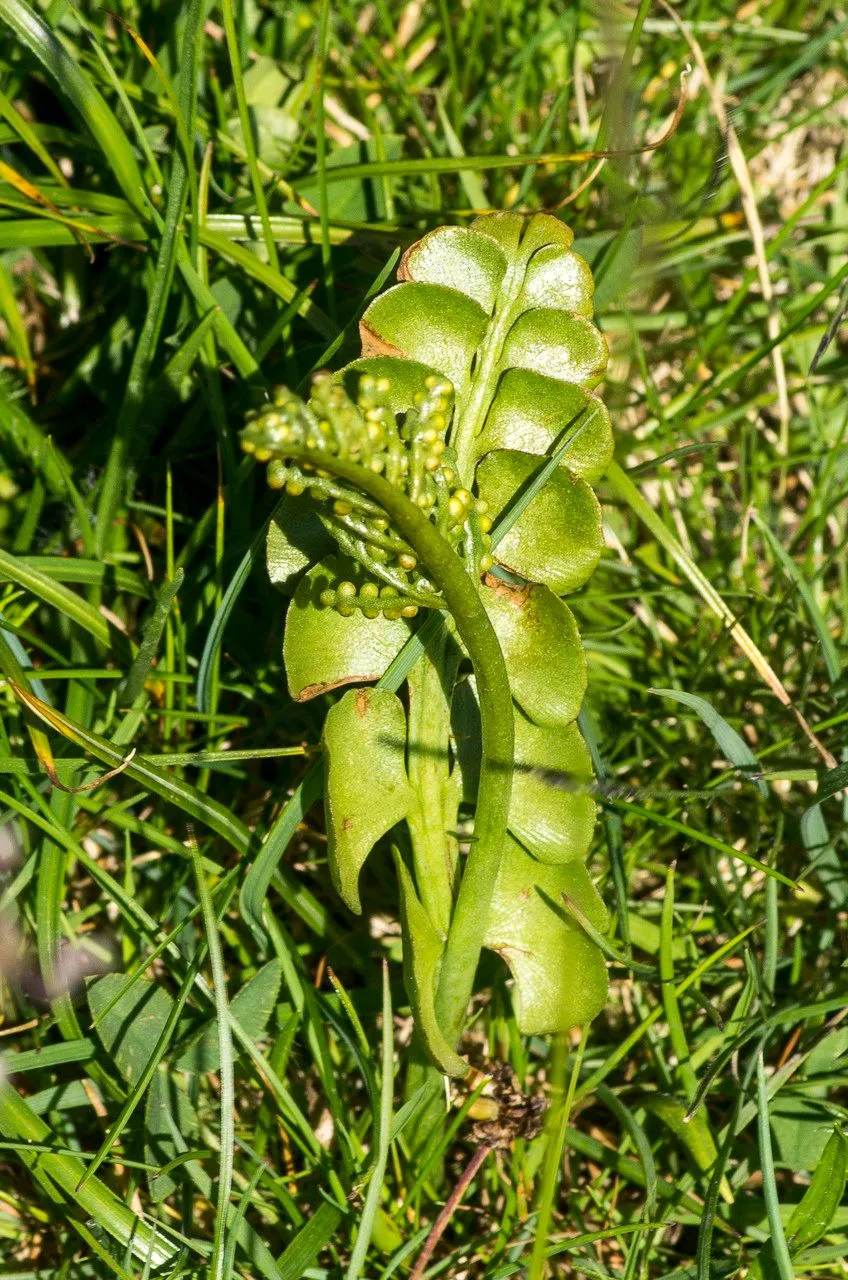
Author: (L.) Sw.
Bibliography: J. Bot. (Schrader) 1800(2): 110 (1801)
Year: 1801
Status: accepted
Rank: species
Genus: Botrychium
Vegetable: False
Observations: Subarctic & Temp. Northern Hemisphere, SE. Australia, New Zealand
The Common moonwort, scientifically known as Botrychium lunaria, is an intriguing species belonging to the Ophioglossaceae family. First chronicled by (L.) Sw. in 1801 in the journal J. Bot. (Schrader) 1800(2): 110, this unique fern-like plant boasts a rich history and notable characteristics that distinguish it in the world of botany.
Characterized by its small size and distinctive crescent-shaped leaflets, Botrychium lunaria is a perennial fern that thrives primarily in subarctic and temperate regions of the Northern Hemisphere. Additionally, it has been observed in the southeastern parts of Australia and New Zealand, suggesting a wide, though somewhat specific, geographical distribution that speaks to its adaptability in varied climates.
One of the most fascinating aspects of the Common moonwort is its life cycle and reproduction. Its subterranean gametophytes—and often inconspicuous above-ground sporophytes—make it a rather elusive subject for study. This underground existence during a part of its life cycle, combined with its small and sometimes singular appearance above ground, gives it an almost mystical reputation among botanists and plant enthusiasts.
This species is particularly intriguing due to its ability to thrive in diverse habitats, from the high, chilly latitudes of the Arctic to the temperate zones spanning the globe. Its resilience and adaptability are iconic, allowing it to colonize a variety of environments, including grasslands, rocky slopes, and the open woodlands where it can often be found emerging in the early summer months.
Despite its hardy nature, the Common moonwort’s specific ecological niches and particular habitat preferences make it both a challenge and a delight to locate in the wild. Conservationists and botanists continue to study Botrychium lunaria to better understand its ecological roles and to ensure that its populations remain robust in the face of environmental changes.
In summary, Botrychium lunaria, the Common moonwort, is a fascinating plant of the Ophioglossaceae family with a broad yet specific distribution across the subarctic and temperate regions of the Northern Hemisphere, as well as parts of the Southern Hemisphere. Its unique life cycle, adaptability, and widespread yet selective habitat preference make it a subject of ongoing interest and study in the botanical community.
Dan: almindelig månerude
Eng: common moonwort, moonwort, moonwort grapefern, unshoe-the-horse
Deu: echte mondraute, mond-rautenfarn, mondraute
Fra: botryche lunaire, herbe à la lune
Nld: gelobde maanvaren
Sme: márjjáčoavdda
Swe: månlåsbräken, låsbräken, vanlig låsbräken
Cym: crib y ceiliog, dibedoliad y meirch, lloer-redyn, lloer-redyn cyffredin, lloer-redynen, lloeredynen gyffredin, lloerlys, lloerlys cyffredin
En: Common moonwort, Moonwort Grape-fern, Moonwort grapefern, MOONWORT, Unshoe-The-Horse
Ar: لسان الغزال القمري
Hy: Ողկուզապտեր կիսալուսնաձև
Bg: Лунна папрат
Zh: 扇羽陰地蕨
Cs: Vratička měsíční
Da: Almindelig Månerude
Nl: Gelobde maanvaren
Et: Kuu-võtmehein
Fo: Tyssismánagras
Fi: Ketonoidanlukko
Fr: Botryche lunaire, Herbe à la lune, Botrychium lunaire
De: Echte Mondraute, Mond-Rautenfarn, Mondraute, Gemeine Mondraute
Hu: Kis holdruta
Is: Tungljurt
Ga: Lus na míosa
It: Botrichio lunaria
Lt: Paprastasis varpenis
Se: Márjjáčoavdda
No: Marinøkkel
Pl: Podejźrzon księżycowy
Ru: Гроздовник полулунный
Es: Lunaria menor
Sv: Låsbräken, Månlåsbräken, Vanlig låsbräken
Zh-tw: 扇羽陰地蕨
Uk: Гронянка півмісяцева
Cy: Lloerlys, Crib y Ceiliog, Dibedoliad y Meirch, Lloer-Redyn, Lloer-Redyn Cyffredin, Lloer-Redynen, Lloeredynen Gyffredin, Lloerlys Cyffredin
Taken Aug 14, 2021 by giancarlo giordano (cc-by-sa)
Taken Jul 7, 2022 by margarida vila (cc-by-sa)
Taken Jul 7, 2022 by margarida vila (cc-by-sa)
Taken May 31, 2022 by parramon marta (cc-by-sa)
Taken Mar 26, 2020 by Guillaume Labeyrie (cc-by-sa)
Taken Jun 5, 2022 by margarida vila (cc-by-sa)
Taken Jul 1, 2021 by Llandrich anna (cc-by-sa)
Taken Jan 1, 1800 by Tela Botanica − Thierry Pernot (cc-by-sa)
Taken Aug 13, 2017 by Yoan MARTIN (cc-by-sa)
Taken Aug 9, 2006 by Reinhard Bachmann (cc-by-sa)
© copyright of the Board of Trustees of the Royal Botanic Gardens, Kew.
© copyright of the Board of Trustees of the Royal Botanic Gardens, Kew.
© copyright of the Board of Trustees of the Royal Botanic Gardens, Kew.
Taken Jul 15, 2012 by Tela Botanica − Yoan MARTIN (cc-by-sa)
Taken Jul 27, 2012 by Tela Botanica − Yoan MARTIN (cc-by-sa)
Taken Aug 20, 2010 by Tela Botanica − Yoan MARTIN (cc-by-sa)
Taken Jun 9, 2018 by François Munoz (cc-by-sa)
Taken Jun 19, 2021 by Dominique Wernert (cc-by-sa)
Taken Jun 18, 2015 by Tela Botanica − Jean-Jacques HOUDRÉ (cc-by-sa)
Taken Jun 18, 2015 by Tela Botanica − Jean-Jacques HOUDRÉ (cc-by-sa)
Taken Jun 18, 2015 by Tela Botanica − Jean-Jacques HOUDRÉ (cc-by-sa)
Taken Jun 5, 2014 by Tela Botanica − Jean-Claude CALAIS (cc-by-sa)
Taken Jul 11, 2016 by Tela Botanica − Jean-Luc GORREMANS (cc-by-sa)
Taken Jan 1, 1970 by Photoflora – L’Abbé COSTE (©)
Taken Jul 15, 2017 by Photoflora – Benoit BOCK (©)
Taken Jul 15, 2007 by Photoflora – Benoit BOCK (©)
Taken Jan 1, 2000 by Tela Botanica − La Spada Arturo (cc-by-sa)
Taken Jun 9, 1991 by Tela Botanica − Liliane Roubaudi (cc-by-sa)
Taken Jul 6, 2020 by Guerrero joaquin (cc-by-sa)
Taken Jun 24, 2019 by Llandrich anna (cc-by-sa)
Taken Jun 18, 2019 by Llandrich anna (cc-by-sa)
Taken Jun 13, 2020 by Llandrich anna (cc-by-sa)
Growth form: Rhizomatous
Growth habit: Forb/herb
Growth rate: Slow
Ph maximum: 7.2
Ph minimum: 5.8
Light: 8
Atmospheric humidity: 5
Soil nutriments: 2
Family: Myrtaceae Author: (F.Muell.) K.D.Hill & L.A.S.Johnson Bibliography: Telopea 6: 402 (1995) Year: 1995 Status:…
Family: Rubiaceae Author: Pierre ex A.Froehner Bibliography: Notizbl. Bot. Gart. Berlin-Dahlem 1: 237 (1897) Year:…
Family: Sapindaceae Author: Koidz. Bibliography: J. Coll. Sci. Imp. Univ. Tokyo 32(1): 38 (1911) Year:…
Family: Asteraceae Author: A.Gray Bibliography: Pacif. Railr. Rep.: 107 (1857) Year: 1857 Status: accepted Rank:…
Family: Fabaceae Author: Medik. Bibliography: Vorles. Churpfälz. Phys.-Ökon. Ges. 2: 398 (1787) Year: 1787 Status:…
Family: Aspleniaceae Author: (Cav.) Alston Bibliography: Bull. Misc. Inform. Kew 1932: 309 (1932) Year: 1932…